First Alert P900E Bruksanvisning
First Alert
Røykvarsler
P900E
Les nedenfor 📖 manual på norsk for First Alert P900E (2 sider) i kategorien Røykvarsler. Denne guiden var nyttig for 11 personer og ble vurdert med 4.5 stjerner i gjennomsnitt av 6 brukere
Side 1/2
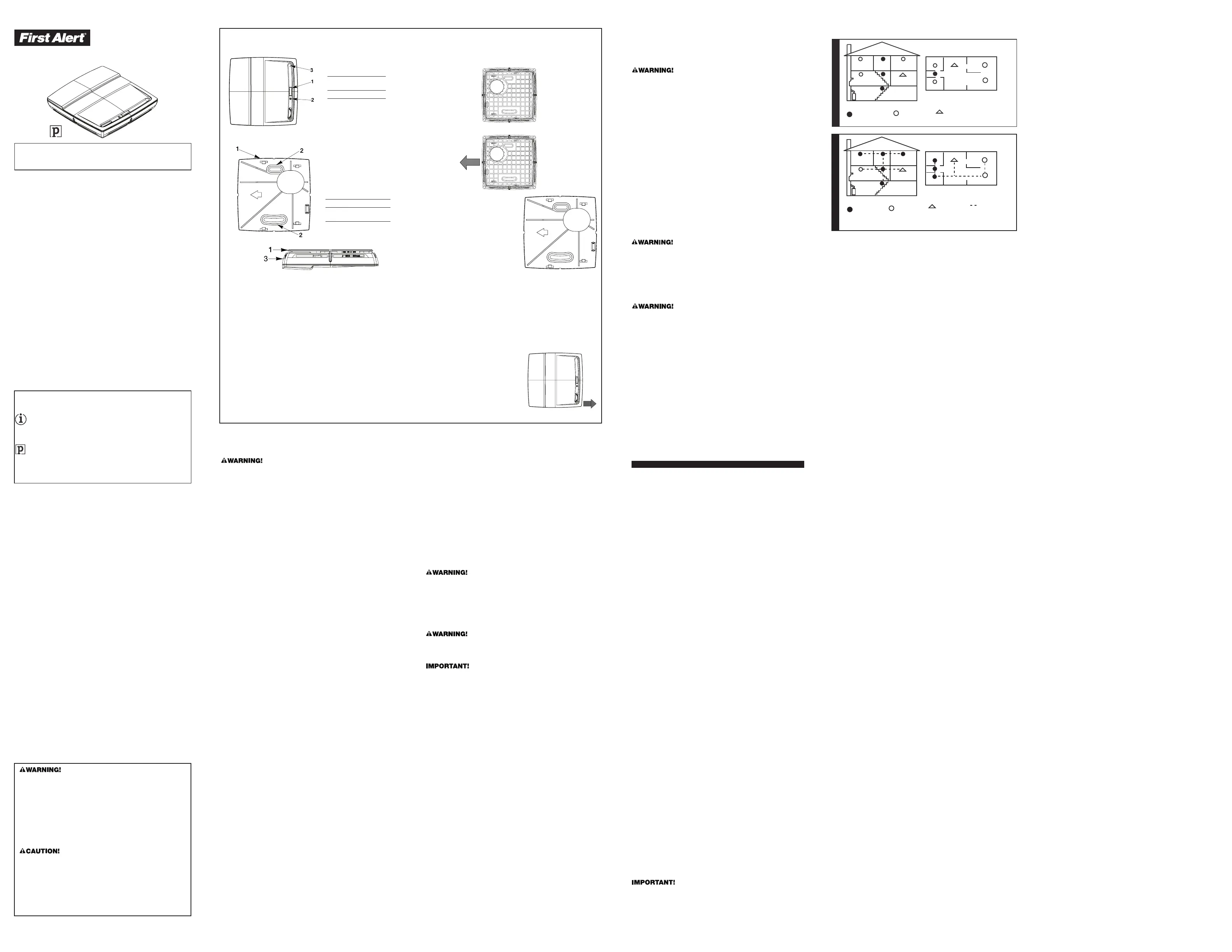
IMPORTANT! PLEASE READ CAREFULLY AND SAVE.
T
his user’s manual contains important information about your Smoke
A
larm’s operation. If you are installing this Smoke Alarm for use by
o
thers, you must leave this manual—or a copy of it—with the end user.
USER’S MANUAL
P
rinted in Mexico
M
08-0406-002 K1 11/12
INTRODUCTION
Thank you for choosing First Alert
®
for your Smoke Alarm needs. You
have purchased a state of the art Smoke Alarm designed to provide you
with early warning of a fire. Please take the time to read this manual and
make the Smoke Alarm an integral part of your family’s safety plan.
K
ey Features of the P900E Smoke Alarm:
P
hotoelectric Sensing Technology: Photoelectric Sensors are generally
m
ore sensitive than ionization sensors in detecting smoldering fires
which commonly occur in couches or bedding.
O
ptiPath 360 Technology™: Patented technology provides 360° of
d
irect access to the smoke sensor.
S
ingle Test/Silence Button: Allows you to test the alarm or silence
n
uisance alarms. Testing the Alarm assures you that the unit is functioning
c
orrectly and ready to protect you and your family. The Alarm can be
s
ilenced for up to 15 minutes in the event of a nuisance alarm.
Escape Light
®
: Bright LED escape light activates when this unit goes
into alarm to illuminate your path to safety.
B
attery Door with “battery missing” lockout:
T
he battery door will not close if a battery has not been inserted thus
a
lerting you that the unit is not powered and not operating.
L
ow battery warning: The Alarm will sound a “chirp” once per minute
w
hen the battery needs to be replaced.
B
linking Power Indicator: Confirms that the Smoke Alarm is receiving
power.
© 2012 BRK Brands, Inc. All rights reserved.
Distributed by BRK Brands, Inc.
3901 Liberty Street Road, Aurora, IL 60504-8122
Consumer Affairs: (800) 323-9005 • www.firstalert.com
FIRE SAFETY TIPS
Follow safety rules and prevent hazardous situations: 1) Use smoking
materials properly. Never smoke in bed. 2) Keep matches or lighters
away from children; 3) Store flammable materials in proper containers;
4) Keep electrical appliances in good condition and don’t overload elec-
trical circuits; 5) Keep stoves, barbecue grills, fireplaces and chimneys
grease- and debris-free; 6) Never leave anything cooking on the stove
unattended; 7) Keep portable heaters and open flames, like candles,
away from flammable materials; 8) Don’t let rubbish accumulate.
Keep alarms clean, and test them weekly. Replace alarms immediately
if they are not working properly. Smoke Alarms that do not work cannot
alert you to a fire. Keep at least one working fire extinguisher on every
floor, and an additional one in the kitchen. Have fire escape ladders or
other reliable means of escape from an upper floor in case stairs are
blocked.
BEFORE YOU INSTALL THIS SMOKE ALARM
Important! Read “Recommended Locations for Smoke Alarms” and
“Locations to Avoid for Smoke Alarms” before beginning. This unit
monitors the air, and when smoke reaches its sensing chamber,
it alarms. It can give you more time to escape before fire spreads.
This unit can ONLY give an early warning of developing fires if it is
installed, maintained and located where smoke can reach it, and where
all residents can hear it, as described in this manual. This unit will not
sense gas, heat, or flame. It cannot prevent or extinguish fires.
Understand The Different Type of Smoke Alarms
Battery powered or electrical? Different Smoke Alarms provide
different types of protection. See “About Smoke Alarms” for details.
Know Where To Install Your Smoke Alarms
Fire Safety Professionals recommend at least one Smoke Alarm on
every level of your home, in every bedroom, and in every bedroom
hallway or separate sleeping area. See “Recommended Locations
For Smoke Alarms” and “Locations To Avoid For Smoke Alarms” for
details.
Know What Smoke Alarms Can and Can’t Do
A Smoke Alarm can help alert you to fire, giving you precious time to
escape. It can only sound an alarm once smoke reaches the sensor.
See “Limitations of Smoke Alarms” for details.
Check Your Local Building Codes
This Smoke Alarm is designed to be used in a typical single-family
home. It alone will not meet requirements for boarding houses,
apartment buildings, hotels or motels. See “Special Compliance
Considerations” for details.
HOW TO INSTALL THIS SMOKE ALARM
THE PARTS OF THIS SMOKE ALARM
FOLLOW THESE SIMPLE STEPS:
*All First Alert
®
Smoke Alarms conform to regulatory requirements,
including UL217 and are designed to detect particles of combustion.
Smoke particles of varying number and size are produced in all fires.
I
onization technology is generally more sensitive than photoelectric
t
echnology at detecting small particles, which tend to be produced
i
n greater amounts by flaming fires, which consume combustible
m
aterials rapidly and spread quickly. Sources of these fires may include
p
aper burning in a wastebasket, or a grease fire in the kitchen.
P
hotoelectric technology is generally more sensitive than ionization
t
echnology at detecting large particles, which tend to be produced
i
n greater amounts by smoldering fires, which may smolder for
h
ours before bursting into flame. Sources of these fires may include
c
igarettes burning in couches or bedding.
F
or maximum protection, use both types of Smoke Alarms on each
l
evel and in every bedroom of your home.
• This unit will not alert hearing impaired residents. It is recom-
mended that you install special units which use devices like
flashing strobe lights to alert hearing impaired residents.
• Do not connect this unit to any other alarm or auxiliary
device. It is a single-station unit that cannot be linked to other
devices. Connecting anything else to this unit may prevent it
from working properly.
• Unit will not operate without battery power. The Smoke Alarm
cannot work until you install the battery in the correct position
(Match “+” to “+” and “-” to “-”).
• This Smoke Alarm has a battery door which resists closing
unless a battery is installed.
• Do not install this unit over an electrical junction box.
Air currents around junction boxes can prevent smoke from
reaching the sensing chamber and prevent the unit from
alarming. Only AC powered units are intended for installation
over junction boxes.
• Do not stand too close to the unit when the alarm is sounding.
It is loud to wake you in an emergency. Exposure to the horn
at close range may harm your hearing.
• Do not paint over the unit. Paint may clog the openings to the
sensing chamber and prevent the unit from operating properly.
1 2 3
1. Mounting bracket
2. Mounting slots
3. Battery door, install 9V
battery here
1. Test/Silence button
2
. Power indicator light
a
nd alarm indicator
3. LED Escape Light
®
1. Turn alarm upside down so the circular shape is located in the
upper left corner of the alarm.
2
. Slide mounting bracket to the left and lift to separate it from the
b
ase.
3. Hold the mounting bracket against
the ceiling (or wall) so the arrow
located on the mounting plate is
pointing to the left. (The circular
shape will now be in upper
right-hand corner). Trace around
the insides of the mounting slots.
4. Put the unit where it won’t get
covered with dust when you drill
the mounting holes.
5
. Using a 3/16” (5 mm) drill bit, drill
a
hole through the center of the
o
val outlines you traced in step #3.
6. Insert the plastic screw anchors (in the plastic bag with screws)
into the holes. Tap the screw anchors gently with a hammer, if
necessary, until they are flush with the ceiling or wall.
7. Attach the mounting bracket to the ceiling or wall.
8
. Install the battery (included). Open the battery door. Match the
t
erminals on the ends of the battery with the terminals on the unit.
M
atch “+” to “+” and “-” to “-.” Push the battery in until it snaps
s
ecurely and cannot be shaken loose. If the battery is not snapped
i
n completely, the unit cannot receive battery power.
N
OTE: After you install the battery, the power indicator light may
f
lash. (If the unit alarms, the light will blink rapidly, and the horn
w
ill repeatedly sound 3 beeps, pause, 3 beeps.)
9
. Attach the Smoke Alarm to the
m
ounting bracket. Line up the arrow
o
n the back of the unit to the arrow
o
n the mounting bracket. When the
u
nits are lined up, slide the alarm to
t
he right until it snaps into place.
NOTE: Once the Smoke Alarm is
snapped onto the mounting bracket,
you can rotate the Smoke Alarm to
adjust the alignment.
1
0. Test the Smoke Alarm. See “Weekly Testing.”
I
F THIS SMOKE ALARM SOUNDS
RESPONDING TO AN ALARM
D
uring an alarm, you will hear a loud, repeating horn pattern:
3
beeps, pause, 3 beeps, pause. The Escape Light
®
w
ill turn on.
L
ED flashes once every second.
• If the unit alarms get everyone out of the house immediately.
•
If the unit alarms and you are not testing the unit, it is warning
y
ou of a potentially dangerous situation that requires your
i
mmediate attention. NEVER ignore any alarm. Ignoring the
a
larm may result in injury or death.
• Never remove the batteries from a battery operated Smoke Alarm
to stop an unwanted alarm (caused by cooking smoke, etc.).
Removing batteries disables the alarm so it cannot sense smoke,
and removes your protection. Instead open a window or fan the
smoke away from the unit. The alarm will reset automatically.
IF YOU SUSPECT A PROBLEM
Smoke Alarms may not operate properly because of dead, missing or
weak batteries, a build-up of dirt, dust or grease on the Smoke Alarm
cover, or installation in an improper location. Clean the Smoke Alarm as
described in “Regular Maintenance,” and install a fresh battery, then test
the Smoke Alarm again. If it fails to test properly when you use the test
button, or if the problem persists, replace the Smoke Alarm immediately.
• If you hear a “chirp” about once a minute, replace the battery.
•
If you experience frequent non-emergency alarms (like those
c
aused by cooking smoke), try relocating the Smoke Alarm.
• If the alarm sounds when no smoke is visible, try cleaning or
relocating the Smoke Alarm. The cover may be dirty.
•
If the alarm does not sound during testing, try installing a new
b
attery, and make sure it is snapped in securely.
•
The Escape Light
®
b
ulb is not replaceable. In the unlikely event
t
hat the Escape Light
®
d
oes not operate during testing, please
o
btain warranty service.
If the Smoke Alarm is still not operating properly, and it is still under
warranty, please see “How to Obtain Warranty Service” in the Limited
Warranty.
D
o not try fixing the alarm yourself – this will void your warranty!
SMOKE AND FIRE* ALARM
LIMITED WARRANTY
B
RK Brands, Inc., ("BRK") the maker of First Alert
®
b
rand products
w
arrants that for a period of ten years from the date of purchase, this
p
roduct will be free from defects in material and workmanship. BRK, at
i
ts option, will repair or replace this product or any component of the
p
roduct found to be defective during the warranty period. Replacement
w
ill be made with a new or remanufactured product or component.
I
f the product is no longer available, replacement may be made with a
s
imilar product of equal or greater value. This is your exclusive warranty.
This warranty is valid for the original retail purchaser from the date of
initial retail purchase and is not transferable. Keep the original sales
receipt. Proof of purchase is required to obtain warranty performance.
BRK dealers, service centers, or retail stores selling BRK products do
not have the right to alter, modify or any way change the terms and
conditions of this warranty.
T
his warranty does not cover normal wear of parts or damage resulting
f
rom any of the following: negligent use or misuse of the product, use on
i
mproper voltage or current, use contrary to the operating instructions,
disassembly, repair or alteration by anyone other than BRK or an
authorized service center. Further, the warranty does not cover Acts of
God, such as fire, flood, hurricanes and tornadoes or any batteries that
are included with this unit.
BRK shall not be liable for any incidental or consequential damages
caused by the breach of any express or implied warranty. Except to
the extent prohibited by applicable law, any implied warranty of
merchantability or fitness for a particular purpose is limited in duration
to the duration of the above warranty. Some states, provinces or
jurisdictions do not allow the exclusion or limitation of incidental or
consequential damages or limitations on how long an implied warranty
lasts, so the above limitations or exclusion may not apply to you. This
warranty gives you specific legal rights, and you may also have other
rights that vary from state to state or province to province.
How to Obtain Warranty Service
Service: If service is required, do not return the product to your retailer.
In order to obtain warranty service, contact the Consumer Affairs
Division at 1-800-323-9005, 7:30 AM - 5:00 PM Central Standard Time,
Monday through Friday. To assist us in serving you, please have the
model number and date of purchase available when calling.
For Warranty Service return to: 25 Spur Drive, El Paso, TX 79906
Battery: BRK Brands, Inc. make no warranty, express or implied, written
or oral, including that of merchantability or fitness for any particular
purpose with respect to battery.
RECOMMENDED LOCATIONS FOR
SMOKE ALARMS
Installing Smoke Alarms in Single-Family Residences
The National Fire Protection Association (NFPA), recommends one
Smoke Alarm on every floor, in every sleeping area, and in every bed-
room. In new construction, the Smoke Alarms must be AC powered and
interconnected. See “Agency Placement Recommendations” for details.
For additional coverage, it is recommended that you install a Smoke
Alarm in all rooms, halls, storage areas, finished attics, and basements,
where temperatures normally remain between 40˚ F (4.4˚ C) and 100˚ F
(37.8˚ C). Make sure no door or other obstruction could keep smoke
from reaching the Smoke Alarms.
More specifically, install Smoke Alarms:
•
On every level of your home, including finished attics and basements.
• Inside every bedroom, especially if people sleep with doors closed.
• In the hall near every sleeping area. If your home has multiple
sleeping areas, install a unit in each. If a hall is over 40 feet (12
meters) long, install an alarm at each end.
• At the top of the first-to-second floor stairway, and at bottom of
basement stairway.
Specific requirements for Smoke Alarm installation vary from state to
state and from region to region. Check with your local Fire Department
for current requirements in your area. It is recommended AC or AC/DC
units be interconnected for added protection.
See “Recommended Locations For Smoke Alarms” diagram on the
following page.
AGENCY PLACEMENT RECOMMENDATIONS
NFPA 72 Chapter 29
“
For your information, the National Fire Alarm and Signaling Code,
N
FPA 72, reads as follows:”
2
9.5.1* Required Detection.
2
9.5.1.1* Where required by other governing laws, codes, or standards
f
or a specific type of occupancy, approved single and multiple-station
s
moke alarms shall be installed as follows:
(
1)*In all sleeping rooms and guest rooms
(
2)*Outside of each separate dwelling unit sleeping area, within 21 ft
(
6.4 m) of any door to a sleeping room, with the distance measured
a
long a path of travel
(
3) On every level of a dwelling unit, including basements
(4) On every level of a residential board and care occupancy (small
facility), including basements and excluding crawl spaces and
unfinished attics
(
5)*In the living area(s) of a guest suite
(
6) In the living area(s) of a residential board and care occupancy
(
small facility)
(Reprinted with permission from NFPA 72
®
, National Fire Alarm and
Signaling Code Copyright © 2010 National Fire Protection Association,
Quincy, MA 02269. This reprinted material is not the complete and
official position of the National Fire Protection Association, on the
referenced subject which is represented only by the standard in its
entirety), (National Fire Alarm and Signaling Code
®
and NFPA 72
®
are
registered trademarks of the National Fire Protection Association, Inc.,
Quincy, MA 02269).
California State Fire Marshal (CSFM)
Early warning detection is best achieved by the installation of fire
detection equipment in all rooms and areas of the household as follows:
A Smoke Alarm installed in each separate sleeping area (in the vicinity,
but outside bedrooms), and Heat or Smoke Alarms in the living rooms,
dining rooms, bedrooms, kitchens, hallways, finished attics, furnace
rooms, closets, utility and storage rooms, basements, and attached
garages.
LOCATIONS TO AVOID FOR SMOKE ALARMS
For best performance, it is recommended you AVOID installing
Smoke Alarms in these areas:
•
Where combustion particles are produced. Combustion particles
f
orm when something burns. Areas to avoid include poorly ventilated
k
itchens, garages, and furnace rooms. Keep units at least 20 feet
(
6 meters) from the sources of combustion particles (stove, furnace,
w
ater heater, space heater) if possible. In areas where a 20-foot
(
6-meter) distance is not possible – in modular, mobile, or smaller
h
omes, for example – it is recommended the Smoke Alarm be
p
laced as far from these fuel-burning sources as possible. The
p
lacement recommendations are intended to keep these Alarms at
a
reasonable distance from a fuel-burning source, and thus reduce
“
unwanted” alarms. Unwanted alarms can occur if a Smoke Alarm
i
s placed directly next to a fuel-burning source. Ventilate these
a
reas as much as possible.
• In air streams near kitchens. Air currents can draw cooking smoke
into the sensing chamber of a Smoke Alarm near the kitchen.
• In very damp, humid or steamy areas, or directly near bathrooms
with showers. Keep units at least 10 feet (3 meters) away from
showers, saunas, dishwashers, etc.
• Where the temperatures are regularly below 40˚ F (4.4˚ C) or above
100˚ F (37.8˚ C), including unheated buildings, outdoor rooms,
porches, or unfinished attics or basements.
• In very dusty, dirty, or greasy areas. Do not install a Smoke Alarm
directly over the stove or range. Keep laundry room Smoke Alarms
free of dust or lint.
• Near fresh air vents, ceiling fans, or in very drafty areas. Drafts can
blow smoke away from the unit, preventing it from reaching the
sensing chamber.
• In insect infested areas. Insects can clog openings to the sensing
chamber and cause unwanted alarms.
• Less than 12 inches (305mm) away from fluorescent lights.
Electrical “noise” can interfere with the sensor.
• In “dead air” spaces. “Dead air” spaces may prevent smoke from
reaching the Smoke Alarm.
Avoiding Dead Air Spaces
“Dead air” spaces may prevent smoke from reaching the Smoke Alarm.
To avoid dead air spaces, follow the installation recommendations
below.
On ceilings, install Smoke Alarms as close to the center of the ceiling
as possible. If this is not possible, install the Smoke Alarm at least 4
inches (102 mm) from the wall or corner.
For wall mounting (if allowed by building codes), the top edge of
Smoke Alarms should be placed between 4 and 12 inches (102 and
305 mm) from the wall/ceiling line, below typical “dead air” spaces.
On a peaked, gabled, or cathedral ceiling, install the first Smoke
Alarm within 3 feet (0.9 meters) of the peak of the ceiling, measured
horizontally. Additional Smoke Alarms may be required depending on
the length, angle, etc. of the ceiling's slope. Refer to NFPA 72 for
details on requirements for sloped or peaked ceilings.
SPECIAL COMPLIANCE CONSIDERATIONS
T
his Smoke Alarm is suitable for use in apartments, condominiums,
t
ownhouses, hospitals, day care facilities, health care facilities, boarding
h
ouses, group homes and dormitories provided a primary fire detection
s
ystem already exists to meet fire detection requirements in common
a
reas like lobbies, hallways, or porches. Using this Smoke Alarm in
c
ommon areas may not provide sufficient warning to all residents or
m
eet local fire protection ordinances/regulations.
This Smoke Alarm alone is not a suitable substitute for complete fire
detection systems in places housing many people—like apartment
buildings, condominiums, hotels, motels, dormitories, hospitals, health
care facilities, nursing homes, day care facilities, or group homes of any
kind. It is not a suitable substitute for complete fire detection systems
in warehouses, industrial facilities, commercial buildings, and special-
purpose non-residential buildings which require special fire detection
and alarm systems. Depending on the building codes in your area, this
Smoke Alarm may be used to provide additional protection in these
facilities.
I
n new construction, most building codes require the use of AC or
A
C/DC powered Smoke Alarms only. In existing construction, AC,
A
C/DC, or DC powered Smoke Alarms can be used as specified by
l
ocal building codes. Refer to NFPA 72 (National Fire Alarm and
S
ignaling Code) and NFPA 101 (Life Safety Code), local building codes,
o
r consult your Fire Department for detailed fire protection requirements
i
n buildings not defined as “households”.
LIMITATIONS OF SMOKE ALARMS
S
moke Alarms have played a key role in reducing deaths resulting from
h
ome fires worldwide. However, like any warning device, Smoke Alarms
c
an only work if they are properly located, installed, and maintained,
a
nd if smoke reaches them. They are not foolproof.
Smoke alarms may not waken all individuals. Practice the escape
plan at least twice a year, making sure that everyone is involved – from
kids to grandparents. Allow children to master fire escape planning and
practice before holding a fire drill at night when they are sleeping.
If children or others do not readily waken to the sound of the smoke
alarm, or if there are infants or family members with mobility limitations,
make sure that someone is assigned to assist them in fire drill and in
the event of an emergency. It is recommended that you hold a fire drill
while family members are sleeping in order to determine their response
to the sound of the smoke alarm while sleeping and to determine
whether they may need assistance in the event of an emergency.
Smoke Alarms cannot work without power. Battery operated units
cannot work if the batteries are missing, disconnected or dead, if the
wrong type of batteries are used, or if the batteries are not installed
correctly. AC units cannot work if the AC power is cut off for any reason
(open fuse or circuit breaker, failure along a power line or at a power
station, electrical fire that burns the electrical wires, etc.). If you are
concerned about the limitations of battery or AC power, install both
types of units.
S
moke Alarms cannot detect fires if the smoke does not reach
t
hem. Smoke from fires in chimneys or walls, on roofs, or on the other
s
ide of closed doors may not reach the sensing chamber and set off the
a
larm. That is why one unit should be installed inside each bedroom or
s
leeping area—especially if bedroom or sleeping area doors are closed
a
t night—and in the hallway between them.
Smoke Alarms may not detect fire on another floor or area of the
home. For example, a stand-alone unit on the second floor may not
detect smoke from a basement fire until the fire spreads. This may not
give you enough time to escape safely. That is why recommended
minimum protection is at least one unit in every sleeping area, and every
bedroom on every level of your home. Even with a unit on every floor,
stand-alone units may not provide as much protection as interconnected
units, especially if the fire starts in a remote area. Some safety experts
recommend installing interconnected AC powered units with battery
back-up (see “About Smoke Alarms”) or professional fire detection
systems, so if one unit senses smoke, all units alarm. Interconnected
units may provide earlier warning than stand-alone units since all units
alarm when one detects smoke.
Smoke Alarms may not be heard. Though the alarm horn in this unit
meets or exceeds current standards, it may not be heard if: 1) the unit
is located outside a closed or partially closed door, 2) residents recently
consumed alcohol or drugs, 3) the alarm is drowned out by noise from
stereo, TV, traffic, air conditioner or other appliances, 4) residents are
hearing impaired or sound sleepers. Special purpose units, like those
with visual and audible alarms, should be installed for hearing impaired
residents.
Smoke Alarms may not have time to alarm before the fire itself
causes damage, injury, or death, since smoke from some fires may
not reach the unit immediately. Examples of this include persons
smoking in bed, children playing with matches, or fires caused by
violent explosions resulting from escaping gas.
Smoke Alarms are not foolproof. Like any electronic device, Smoke
Alarms are made of components that can wear out or fail at any time.
You must test the unit weekly to ensure your continued protection.
Smoke Alarms cannot prevent or extinguish fires. They are not a
substitute for property or life insurance.
Smoke Alarms have a limited life. The unit should be replaced
immediately if it is not operating properly. You should always replace a
Smoke Alarm after 10 years from date of purchase. Write the purchase
date on the space provided on back of unit.
First Alert
®
is a registered trademark of the First Alert Trust.
4 5
6
A
BOUT SMOKE ALARMS
Battery (DC) operated Smoke Alarms: Provide protection even when
electricity fails, provided the batteries are fresh and correctly installed.
Units are easy to install, and do not require professional installation.
AC powered Smoke Alarms: Can be interconnected so if one unit
senses smoke, all units alarm. They do not operate if electricity fails.
AC with battery (DC) back-up: will operate if electricity fails, provided
the batteries are fresh and correctly installed. AC and AC/DC units
must be installed by a qualified electrician.
S
moke Alarms for Solar or Wind Energy users and battery backup
p
ower systems: AC powered Smoke Alarms should only be operated
w
ith true or pure sine wave inverters. Operating this Smoke Alarm with
m
ost battery-powered UPS (uninterruptible power supply) products or
s
quare wave or “quasi sine wave” inverters will damage the Alarm.
I
f you are not sure about your inverter or UPS type, please consult with
t
he manufacturer to verify.
Smoke Alarms for the hearing impaired: Special purpose Smoke
Alarms should be installed for the hearing impaired. They include a
visual alarm and an audible alarm horn, and meet the requirements of
the Americans With Disabilities Act. Can be interconnected so if one
unit senses smoke, all units alarm.
Smoke alarms are not to be used with detector guards unless the
combination has been evaluated and found suitable for that purpose.
A
ll these Smoke Alarms are designed to provide early warning of fires if
l
ocated, installed and cared for as described in the user’s manual, and
i
f smoke reaches them. If you are unsure which type of Smoke Alarm
t
o install, refer to Chapter 2 of the National Fire Protection Association
(
NFPA) Standard 72 (National Fire Alarm and Signaling Code) and
N
FPA 101 (Life Safety Code). National Fire Protection Association,
O
ne Batterymarch Park, Quincy, MA 02269-9101. Local building codes
m
ay also require specific units in new construction or in different areas
o
f the home.
B
EDROOM
B
EDROOM
H
ALL
LIVING ROOM KITCHEN
FINISHED BASEMENT
B
EDROOM
BEDROOM
LIVING ROOM
DINING ROOM
M
ULTI-STORY RESIDENCE
S
INGLE-STORY RESIDENCE, APARTMENT,
MOBILE HOME
EXISTING HOMES
KITCHEN
R
EQUIRED TO
MEET NFPA
R
ECOMMENDATIONS
R
ECOMMENDED
FOR ADDITIONAL
P
ROTECTION
K
EY:
S
MOKE ALARMS WITH SILENCE
FEATURES RECOMMENDED FOR
A
DDITIONAL PROTECTION
I
NTERCONNECTED
AC OR AC/DC
SMOKE ALARMS
BEDROOM
BEDROOM
H
ALL
L
IVING ROOM KITCHEN
FINISHED BASEMENT
R
EQUIRED TO
M
EET NFPA
RECOMMENDATIONS
R
ECOMMENDED
FOR ADDITIONAL
P
ROTECTION
BEDROOM
BEDROOM
LIVING ROOM
DINING ROOM
M
ULTI-STORY RESIDENCE
S
INGLE-STORY RESIDENCE, APARTMENT,
MOBILE HOME
KEY:
NEW CONSTRUCTION
SMOKE ALARMS
W
ITH SILENCE
FEATURES
RECOMMENDED
F
OR ADDITIONAL
PROTECTION
KITCHEN
Printed in Mexico M08-0406-002 K1 11/12
RECOMMENDED LOCATIONS FOR SMOKE ALARMS
WHAT TO DO IN CASE OF FIRE
•
Don’t panic; stay calm. Follow your family escape plan.
•
Get out of the house as quickly as possible. Don’t stop to get
d
ressed or collect anything.
• Feel doors with the back of your hand before opening them.
If a door is cool, open it slowly. Don’t open a hot door. Keep doors
and windows closed, unless you must escape through them.
•
Cover your nose and mouth with a cloth (preferably damp).
T
ake short, shallow breaths.
• Meet at your planned meeting place outside your home,
and do a head count to make sure everybody got out safely.
• Call the Fire Department as soon as possible from outside.
Give your address, then your name.
•
Never go back inside a burning building for any reason.
• Contact your Fire Department for ideas on making your home safer.
Alarms have various limitations. See "Limitations of Smoke Alarms"
f
or details.
USING THE SILENCE FEATURE
The Silence Feature can temporarily quiet an unwanted alarm for up to
15 minutes. To use this feature, press the Test/Silence button on the
cover. If the unit will not silence and no heavy smoke is present,
or if it stays in silence mode continuously, it should be replaced
immediately. The LED will flash every 10 seconds while in silence.
T
he Silence Feature does not disable the unit—it makes it temporarily
l
ess sensitive to smoke. For your safety, if smoke around the unit is
d
ense enough to suggest a potentially dangerous situation, the unit
w
ill stay in alarm or may re-alarm quickly. If you do not know the
s
ource of the smoke, do not assume it is an unwanted alarm. Not
r
esponding to an alarm can result in property loss, injury, or death.
TOOLS YOU WILL NEED:
T
his unit is designed to be mounted
o
n the ceiling, or on the wall if necessary.
•
Pencil
•
Drill with 3/16” (5 mm) drill bit
• Standard flathead screwdriver
•
Hammer
•
NEVER use an open flame of any kind to test this unit. You might
a
ccidentally damage or set fire to the unit or to your home.
T
he built-in test switch accurately tests the unit’s operation as
r
equired by Underwriters Laboratories, Inc. (UL).
• If the Alarm ever fails to test properly, replace it immediately.
Products under warranty may be returned to the manufacturer
for replacement. See “Limited Warranty” for details.
• DO NOT stand close to the alarm when the horn is sounding.
Exposure at close range may be harmful to your hearing. When
testing, step away when horn starts sounding.
I
t is important to test this unit every week to make sure it is working
p
roperly. Using the Test/Silence button is the recommended way to
t
est this Smoke Alarm. Press and hold the Test/Silence button on the
c
over of the unit until the alarm sounds and the Escape Light
®
t
urns on
(the unit may continue to alarm for a few seconds after you release the
button). If it does not alarm, make sure the unit is receiving power and
test it again. If it still does not alarm, replace it immediately.
During testing you will hear a loud, repeating horn pattern: 3 beeps,
pause, 3 beeps, pause. The Escape Light
®
will turn on. LED flashes
once every second.
REGULAR MAINTENANCE
This unit has been designed to be as maintenance free as possible, but
there are a few simple things you must do to keep it working properly.
•
Test it at least once a week.
•
Clean the Smoke Alarm at least once a month; gently vacuum off
a
ny dust using your household vacuum’s soft brush attachment,
a
nd test the Smoke Alarm after cleaning. Never use water, cleaners
or solvents since they may damage the unit.
• If the Smoke Alarm becomes contaminated by excessive dirt, dust
and/or grime, and cannot be cleaned to avoid unwanted alarms,
replace the unit immediately.
• Relocate the unit if it sounds frequent unwanted alarms.
See “Locations to Avoid For Smoke Alarms” for details.
• When the battery becomes weak, the Smoke Alarm unit will “chirp”
approximately once a minute (the low battery warning). This low
battery warning should last for up to 7 days, but you should replace
the battery immediately to continue your protection.
Choosing a replacement battery:
Your Smoke Alarm requires one standard 9V battery. The following
batteries are acceptable as replacements: Duracell MN1604, (Ultra)
MX1604; Energizer 522. You may also use a Lithium battery like the
Ultralife U9VL-J-P for longer service life between battery changes.
These batteries are available at many local retail stores.
• Always use the exact batteries specified by this User’s Manual.
DO NOT use rechargeable batteries. Clean the battery contacts
and also those of the device prior to battery installation. Install
batteries correctly with regard to polarity (+ and -).
• Please dispose of or recycle used batteries properly, following
any local regulations. Consult your local waste management
authority or recycling organization to find an electronics
recycling facility in your area. DO NOT DISPOSE OF BATTERIES
IN FIRE. BATTERIES MAY EXPLODE OR LEAK.
• Keep battery out of reach of children. In the event a battery
is swallowed, immediately contact your poison control center,
your physician, or the National Battery Ingestion hotline at
202-625-3333 as serious injury may occur.
Actual service life depends on the Smoke Alarm and the environment
in which it is installed. All the batteries specified above are acceptable
replacement batteries for this unit. Regardless of the manufacturer’s
suggested battery life, you MUST replace the battery immediately once
the unit starts “chirping” (the “low battery warning”).
B
ATTERY POWERED PHOTOELECTRIC SMOKE ALARM
W
ITH SILENCE AND ESCAPE LIGHT
®
C
ONFORMS TO
UL STD 217
Model P900E
WEEKLY TESTING
N
OTE: Be sure to mount the product in the orientation specified
i
n the next steps as this provides the most stability for mounting
t
he product to the wall or ceiling.
Produkspesifikasjoner
| Merke: | First Alert |
| Kategori: | Røykvarsler |
| Modell: | P900E |
Trenger du hjelp?
Hvis du trenger hjelp med First Alert P900E still et spørsmål nedenfor, og andre brukere vil svare deg
Røykvarsler First Alert Manualer
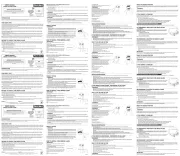
15 September 2025
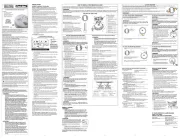
15 September 2025
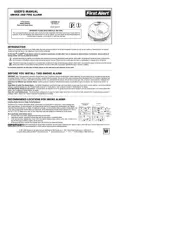
15 September 2025
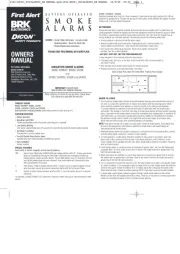
15 September 2025
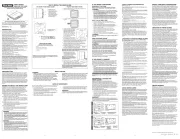
15 September 2025
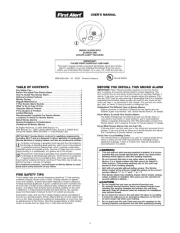
15 September 2025
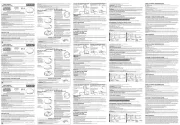
15 September 2025

15 September 2025
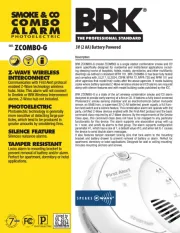
15 September 2025

15 September 2025
Røykvarsler Manualer
- ESYLUX
- Drayton
- Ei Electronics
- Kidde
- Smartwares
- Qolsys
- Heatit
- SAVS
- Somfy
- EQ-3
- Devolo
- Hochiki
- Cordes
- AngelEye
- Nexa
Nyeste Røykvarsler Manualer
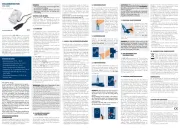
30 September 2025

15 September 2025
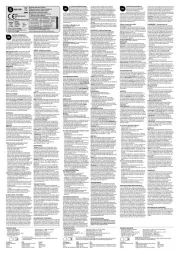
15 September 2025

15 September 2025

15 September 2025

15 September 2025
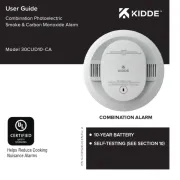
11 September 2025

11 September 2025

11 September 2025

8 September 2025